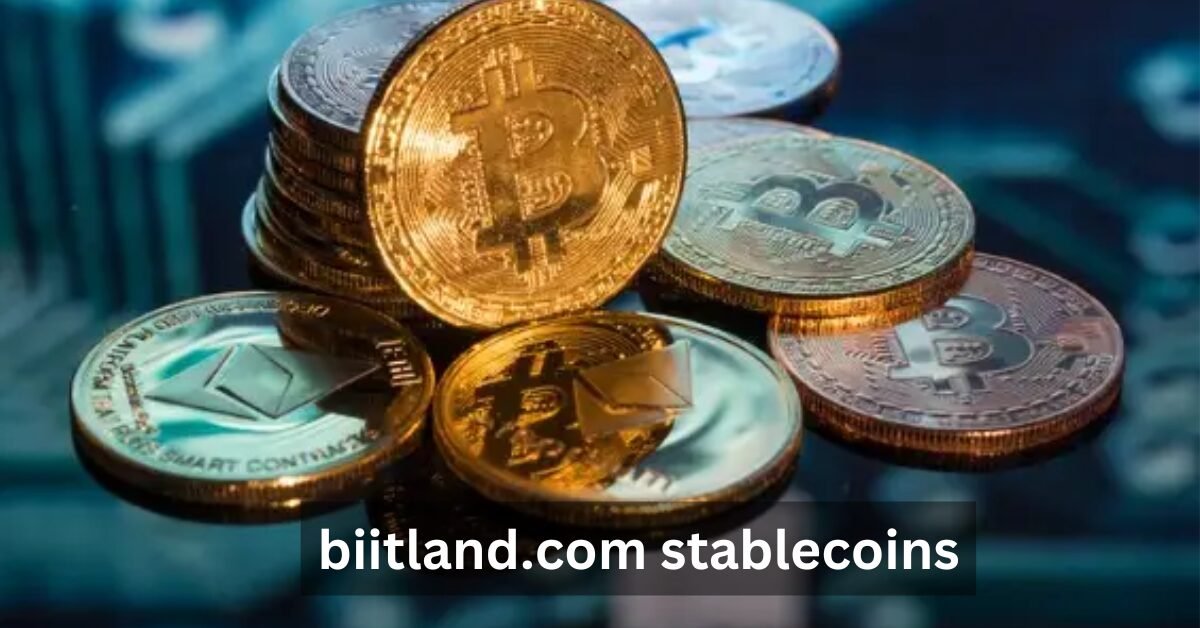Fiat-collateralized stablecoins are backed by traditional fiat currencies like the US dollar, while crypto-collateralized stablecoins are backed by other cryptocurrencies, such as Ethereum. Among the platforms providing educational insights into cryptocurrencies, Biitland.com Stablecoins stands out for its commitment to educating users about Bitcoin, Ethereum, and stablecoins. By offering a range of resources and tools, Biitland.com Stablecoins aims to simplify complex topics, such as stablecoins, for both beginners and seasoned investors.
In this article, we’ll explore Biitland.com Stablecoins’s approach to stablecoins, what stablecoins are, how they function, and why they play a pivotal role in the cryptocurrency ecosystem. We’ll also cover the various types of stablecoins, their real-world use cases, regulatory challenges, and what the future holds for these innovative digital assets.
What Are Stablecoins?

Stablecoins are digital assets designed to maintain a stable value by pegging them to a reserve of assets, typically a fiat currency like the US dollar or a commodity such as gold. The primary objective of stablecoins is to mitigate the price volatility that often characterizes cryptocurrencies like Bitcoin (BTC) and Ethereum (ETH). This makes stablecoins an attractive option for users who want to avoid the extreme fluctuations seen in the broader cryptocurrency market.
Unlike traditional cryptocurrencies, which can see sharp price swings within minutes, stablecoins offer a more reliable store of value. This stability allows them to serve as a medium of exchange, a store of value, and even a unit of account within various cryptocurrency networks and DeFi (Decentralized Finance) platforms.
Overview of Biitland.com Stablecoins’s Role in the Cryptocurrency Space
Biitland.com Stablecoins is a hub for cryptocurrency education, providing users with easy-to-understand content about Bitcoin, Ethereum, blockchain technology, and emerging trends in the cryptocurrency world. It caters to users at all levels of knowledge, from beginners to advanced investors. Through articles, tutorials, and guides, Biitland.com Stablecoins seeks to make complex topics like stablecoins accessible and actionable.
As the demand for stablecoins grows in both the cryptocurrency and traditional financial sectors, Biitland.com Stablecoins has positioned itself as a valuable resource to understand these digital assets. The platform helps bridge the knowledge gap for those interested in learning how stablecoins work and why they are crucial in the future of digital finance.
The Basics of Stablecoins: Key Concepts
Stablecoins are not all created equal. While they share the common feature of maintaining a stable value, their mechanisms and underlying technologies can vary significantly. Understanding the different types of stablecoins and how they function is essential for anyone looking to delve deeper into the world of cryptocurrency.
What Makes a Stablecoin Different from Other Cryptocurrencies?
Unlike traditional cryptocurrencies like Bitcoin and Ethereum, which experience significant volatility, stablecoins are specifically designed to minimize price fluctuations. This is achieved by pegging their value to a reserve of assets, typically fiat currencies such as the US dollar. The stability of a stablecoin makes it an ideal choice for everyday transactions and financial services, especially when compared to the highly volatile nature of other cryptocurrencies.
Stablecoins also offer advantages in terms of speed and cost. Transactions involving stablecoins are typically faster and cheaper than those involving traditional banking systems or even some cryptocurrencies. This makes them attractive for international money transfers, remittances, and peer-to-peer transactions.
Types of Stablecoins: Fiat-Collateralized, Crypto-Collateralized, and Algorithmic Stablecoins
Stablecoins come in several different varieties, each with its own method for maintaining stability.
Fiat-Collateralized Stablecoins: These stablecoins are backed 1:1 by a fiat currency like the US dollar or euro. Popular examples include Tether (USDT), USD Coin (USDC), and TrueUSD (TUSD). For every stablecoin issued, an equivalent amount of fiat currency is held in reserve, ensuring the token’s value remains stable.
Crypto-Collateralized Stablecoins: These stablecoins are backed by other cryptocurrencies like Ethereum or Bitcoin. They are typically over-collateralized to account for the volatility of the underlying assets. A well-known example is DAI, a decentralized stablecoin governed by the MakerDAO protocol.
Algorithmic Stablecoins: These stablecoins are not backed by any collateral but instead rely on algorithms and smart contracts to control the supply and demand of the stablecoin. These mechanisms adjust the total supply to keep the price stable. Examples include Ampleforth (AMPL) and the Terra (LUNA) ecosystem.
How Do Stablecoins Work?
Stablecoins operate through different mechanisms depending on their type. Whether they are fiat-collateralized, crypto-collateralized, or algorithmic, the core principle remains the same: maintain a stable value. Here’s how these mechanisms function:
Mechanisms Behind Stablecoin Stability
The primary mechanism behind stablecoin stability is the use of collateralization or algorithms. For fiat-collateralized stablecoins, the collateral is a reserve of fiat currency, typically held in a secure, transparent account. Every stablecoin issued is backed by an equivalent amount of fiat currency, ensuring that its value remains stable.
Crypto-collateralized stablecoins, on the other hand, are backed by other cryptocurrencies. These stablecoins use smart contracts to adjust the collateralization ratio dynamically to ensure the stability of the token. For instance, if the value of the collateral drops too much, additional collateral is required to maintain the peg.
Pegging to Fiat Currencies and Other Assets
Fiat-collateralized stablecoins are pegged to the value of a fiat currency, such as the US dollar, which means they maintain a 1:1 ratio with the underlying asset. For example, USD Coin (USDC) is pegged to the US dollar, and for every USDC issued, there is a corresponding US dollar held in reserve.
In contrast, some stablecoins are pegged to other assets like commodities (e.g., gold or oil). This adds a layer of diversification, making them less reliant on the performance of a single fiat currency.
Reserve Management in Stablecoins
Reserve management is crucial for ensuring that a stablecoin maintains its peg to its underlying asset. In the case of fiat-collateralized stablecoins, the reserves must be regularly audited and verified to maintain transparency and trust with users. Crypto-collateralized stablecoins use decentralized protocols and smart contracts to adjust the reserve levels automatically, ensuring that the peg remains intact.
The Importance of Stablecoins in the Crypto Ecosystem
Stablecoins are not just another form of cryptocurrency; they play a vital role in making the entire crypto ecosystem more practical and user-friendly. By offering a stable value, they mitigate the challenges that cryptocurrency volatility presents. Let’s take a deeper look at the importance of stablecoins in the broader cryptocurrency landscape.
The Role of Stablecoins in DeFi (Decentralized Finance)
Decentralized Finance (DeFi) refers to financial services that operate on blockchain networks without relying on traditional banks or centralized institutions. DeFi applications enable users to lend, borrow, trade, and invest without intermediaries. However, the volatility of many cryptocurrencies makes it challenging to use them in daily transactions, especially for lending or borrowing purposes.
This is where stablecoins step in. By offering a predictable and stable value, stablecoins are the ideal medium for DeFi transactions. For example, in DeFi lending platforms, borrowers can take out loans denominated in stablecoins, and lenders can earn interest on their stablecoin holdings without worrying about the wild price swings of assets like Bitcoin or Ethereum.
Moreover, stablecoins like USD Coin (USDC) and Tether (USDT) provide liquidity to DeFi markets, making them an essential part of the ecosystem. These stablecoins facilitate peer-to-peer transactions, stable lending and borrowing, and decentralized exchanges, creating a more robust and sustainable financial system that operates outside of traditional banks.
How Stablecoins Facilitate Cryptocurrency Transactions
Stablecoins significantly improve the efficiency of cryptocurrency transactions by offering price stability. When using volatile cryptocurrencies like Bitcoin (BTC) for daily purchases or transfers, there’s a risk that the value could fluctuate within a short time, potentially making the transaction more expensive or less valuable. Stablecoins eliminate this problem by pegging their value to assets like the US dollar, thus providing predictability in price.
Additionally, stablecoins enhance the speed and cost-effectiveness of international money transfers. Cross-border transactions using traditional methods, such as wire transfers, often incur high fees and take several days to process. With stablecoins, transactions can be completed in minutes, and the fees are much lower, making them an attractive option for sending money globally. Platforms like Biitland.com Stablecoins also provide easy-to-understand guides for how users can send and receive stablecoins with ease.
Bridging the Gap Between Traditional Finance and Cryptocurrencies
The integration of stablecoins into the financial system has opened doors for the collaboration between traditional financial institutions and blockchain-based systems. Stablecoins bridge the gap between traditional finance and cryptocurrencies by providing a reliable, digital alternative to fiat currencies. This makes it easier for businesses and individuals to adopt cryptocurrency without the risk of price volatility.
For example, companies like Circle, which issues USD Coin (USDC), have worked to ensure that their stablecoins comply with financial regulations. By adhering to the standards set by regulatory bodies, stablecoins like USDC offer the security and trust required by traditional financial institutions and regulatory authorities.
Biitland.com Stablecoins emphasizes the importance of these developments by educating its users on how stablecoins function within the broader financial system and how they can be used for real-world applications such as international remittances, e-commerce, and decentralized finance.
Biitland.com Stablecoins’s Approach to Stablecoins
Biitland.com Stablecoins serves as an invaluable educational platform for those looking to understand and utilize stablecoins. Whether you are new to cryptocurrency or have been following the space for years, Biitland.com Stablecoins provides comprehensive resources to help you grasp the significance and potential of stablecoins in today’s digital economy.
Educational Resources and Tools on Biitland.com Stablecoins
One of Biitland.com Stablecoins’s core missions is to educate users about cryptocurrency, and stablecoins are a major part of this effort. The platform offers in-depth articles, tutorials, and video content to help users understand the mechanisms behind stablecoins, their types, and how to use them. From beginner-friendly guides to more technical discussions, Biitland.com Stablecoins ensures that users can find content tailored to their level of expertise.
Additionally, Biitland.com Stablecoins’s resources go beyond just understanding stablecoins; they also include practical advice on how to store stablecoins in digital wallets, how to engage in stablecoin lending and borrowing in DeFi, and how to avoid common pitfalls. These tools and resources help users navigate the world of stablecoins with confidence.
How Biitland.com Stablecoins Explains Stablecoin Concepts to Beginners
Biitland.com Stablecoins excels at breaking down complex topics into digestible content. For beginners, understanding stablecoins can be overwhelming, especially with the wide range of stablecoin types and mechanisms. Biitland.com Stablecoins takes a step-by-step approach to explaining these concepts, ensuring that users understand what stablecoins are, how they work, and why they matter in the context of cryptocurrency.
The platform also highlights the practical benefits of stablecoins, such as their ability to facilitate smoother transactions and their role in decentralized finance (DeFi). By simplifying these concepts, Biitland.com Stablecoins makes it easier for newcomers to get started with stablecoins, helping them make informed decisions about their digital assets.
The Significance of Transparency and Trust in Stablecoins on Biitland.com Stablecoins
Trust and transparency are key to the success of stablecoins, especially when it comes to ensuring that the reserve assets backing them are properly managed. Biitland.com Stablecoins emphasizes the importance of transparency in the stablecoin market, regularly reviewing the leading stablecoins’ reserve management practices and ensuring they are adequately backed by tangible assets.
Through partnerships with trusted stablecoin issuers, such as Circle (USDC) and Paxos Trust Company (PAX), Biitland.com Stablecoins reassures users about the credibility and security of the stablecoins they use. By promoting stablecoin projects that adhere to high transparency standards, Biitland.com Stablecoins helps build trust in the digital currency space.
Real-World Use Cases for Stablecoins
Stablecoins have gone beyond being just theoretical concepts and are now actively being used in various industries. From cross-border transactions to decentralized finance, the use cases for stablecoins are numerous and growing.
Cross-Border Transactions and Remittances
One of the most significant advantages of stablecoins is their ability to facilitate cross-border transactions. Sending money internationally through traditional banking systems can be costly and time-consuming. Stablecoins, on the other hand, enable users to send money across borders in minutes and with minimal fees. This makes stablecoins particularly useful for remittances, especially for individuals who need to send money to family members in different countries.
Platforms like Biitland.com Stablecoins provide users with practical advice on how to leverage stablecoins for remittances, helping them avoid the high fees and delays associated with traditional remittance services.
E-commerce and Digital Payments
Stablecoins are also revolutionizing the e-commerce space. By offering a stable alternative to volatile cryptocurrencies, stablecoins allow merchants to accept digital payments without the fear of price fluctuations. Whether it’s for online goods, services, or subscriptions, stablecoins like USD Coin (USDC) and Tether (USDT) are increasingly being used as payment methods.
Biitland.com Stablecoins highlights how merchants and consumers can take advantage of the benefits of stablecoins for everyday purchases, especially in markets where cryptocurrencies have yet to achieve widespread adoption.
DeFi Lending and Borrowing Platforms
Decentralized finance (DeFi) has seen explosive growth in recent years, with stablecoins playing a crucial role. Stablecoins are used extensively in DeFi lending and borrowing platforms, where users can earn interest or take out loans without intermediaries. By using stablecoins, borrowers can lock in predictable loan values, while lenders can earn stable returns without worrying about volatility.
Regulatory Considerations and Challenges for Stablecoins
As stablecoins continue to gain traction in the financial world, they face increasing scrutiny from regulators across the globe. While stablecoins offer several advantages, such as enabling fast, low-cost transactions, they also pose challenges when it comes to regulatory compliance and consumer protection.
Current Stablecoin Regulations and Compliance Efforts
Regulatory bodies are looking closely at stablecoins to ensure that they meet the necessary standards to protect users and maintain the stability of the financial system. In the United States, agencies like the U.S. Securities and Exchange Commission (SEC) and the Commodity Futures Trading Commission (CFTC) are actively engaged in discussions around the regulation of stablecoins.
Some stablecoin issuers, like USD Coin (USDC) and Paxos Standard (PAX), are already compliant with regulations, ensuring that their reserves are properly backed and that their operations are transparent. Additionally, Circle (the issuer of USDC) and Paxos Trust Company have taken steps to ensure that their stablecoins are fully regulated and compliant with financial laws.
Biitland.com Stablecoins provides valuable information to users about the evolving regulatory landscape, ensuring that users understand the legal implications of using stablecoins. The platform also offers insights into how users can stay informed about the latest regulatory changes that may impact stablecoin adoption.
Risks of Regulatory Uncertainty and the Future of Stablecoin Legislation
Despite ongoing efforts to regulate stablecoins, the space remains uncertain. The regulatory frameworks for stablecoins are still developing, and the potential for stricter regulations could impact the future of these digital assets. For example, some jurisdictions have yet to define how stablecoins should be classified or regulated, and there’s concern about the risk of market manipulation or instability if regulations are not properly enforced.
The global nature of stablecoins further complicates regulatory efforts. While some countries have embraced stablecoins and blockchain technology, others have imposed restrictions or outright bans on their use. This creates a fragmented regulatory environment that may hinder the widespread adoption of stablecoins.
At Biitland.com Stablecoins, we keep our users updated on the regulatory environment, helping them navigate these complexities and make informed decisions about stablecoin investments.
Popular Stablecoins in the Market
There are several popular stablecoins in the market today, each with unique features and mechanisms to maintain their stability. Let’s take a closer look at some of the most widely used stablecoins.
A Deep Dive into Tether (USDT), USD Coin (USDC), and DAI
Tether (USDT): Tether is the most widely used stablecoin in the cryptocurrency market. It is pegged 1:1 to the US dollar, meaning one USDT is always intended to be worth one dollar. Tether is widely used across various cryptocurrency exchanges and DeFi platforms due to its liquidity and stability.
USD Coin (USDC): USD Coin (USDC) is another popular fiat-collateralized stablecoin that is fully backed by US dollars held in reserve. It is issued by Circle, a regulated financial institution, and is widely used in DeFi platforms, remittances, and e-commerce. USDC is known for its transparency, with regular attestations from independent auditors confirming that the reserves match the circulating supply.
DAI: Unlike USDT and USDC, DAI is a decentralized stablecoin governed by the MakerDAO community. DAI is collateralized by other cryptocurrencies, primarily Ethereum, which ensures its stability. Through the MakerDAO platform, users can lock up assets to generate DAI and participate in decentralized lending and borrowing.
How Stablecoins are Evolving: Newer Players and Innovations
While Tether, USD Coin, and DAI are the dominant stablecoins, new players are emerging in the market. Innovations in stablecoin technology continue to drive the evolution of this asset class.
For example, projects like Reserve Protocol are working to create a stablecoin backed by a basket of assets rather than a single fiat currency. This approach aims to reduce the risks associated with single-asset-backed stablecoins, making the stablecoin more resilient to market fluctuations.
Additionally, Celo Dollar (cUSD) focuses on mobile-first users, offering a stablecoin designed to be easily accessible through smartphones. This innovation could play a significant role in driving the adoption of stablecoins in developing countries where access to traditional banking services is limited.
Biitland.com Stablecoins closely follows these innovations, providing users with up-to-date information about emerging stablecoins and the technology behind them.
Comparing Biitland.com Stablecoins Stablecoin Insights with Popular Stablecoins

Biitland.com Stablecoins takes a unique approach to stablecoin education. While platforms like Tether (USDT) and USD Coin (USDC) are widely recognized in the market, Biitland.com Stablecoins strives to offer users more than just basic facts about stablecoins. The platform provides a comprehensive look at the underlying mechanisms, reserve management, and market trends that influence stablecoin adoption.
By offering detailed insights into how different stablecoins function, Biitland.com Stablecoins empowers users to understand not only the popular stablecoins but also the newer entrants that are reshaping the space. This comprehensive approach makes Biitland.com Stablecoins a go-to platform for those looking to learn more about stablecoins and their role in the broader cryptocurrency ecosystem.
The Future of Stablecoins and Their Potential Impact
Stablecoins are poised to have a significant impact on the future of both cryptocurrency and traditional finance. As the world becomes more digitized and interconnected, stablecoins offer a bridge between the traditional banking system and the rapidly evolving world of decentralized finance (DeFi).
Innovations in Stablecoin Technology
Stablecoin technology is continuously evolving to improve scalability, security, and user experience. One of the most significant innovations in this space is the development of algorithmic stablecoins, which use algorithms to control their supply and demand in an attempt to maintain a stable value. While still in the experimental phase, these stablecoins have the potential to disrupt the traditional fiat-collateralized stablecoin model.
Additionally, cross-chain interoperability is a major focus for the future of stablecoins. By enabling stablecoins to operate across different blockchain networks, users can more easily access liquidity, engage in DeFi applications, and conduct transactions without being restricted to a single blockchain.
How Stablecoins Could Shape the Future of Global Finance
The widespread adoption of stablecoins could fundamentally change the way people interact with money. By offering a stable, decentralized alternative to traditional fiat currencies, stablecoins could potentially reduce the need for intermediaries in financial transactions, lower transaction costs, and enable faster payments across borders.
Moreover, stablecoins could play a major role in financial inclusion. In countries with unstable currencies or limited access to traditional banking, stablecoins could provide individuals with a reliable store of value and a means of participating in the global economy.
Biitland.com Stablecoins continues to explore these possibilities, offering insights into how stablecoins could be integrated into various sectors of the economy and what the future holds for digital finance.
Conclusion
Stablecoins have emerged as one of the most exciting developments in the world of cryptocurrency. Their ability to provide stability in an otherwise volatile market has made them a crucial tool for DeFi, international remittances, and e-commerce.
The value proposition of stablecoins—offering the best of both worlds, stability and decentralization—makes them an attractive option for a wide range of use cases. Whether it’s facilitating peer-to-peer transactions, powering DeFi applications, or offering a bridge between traditional finance and cryptocurrencies, stablecoins are set to play a central role in the digital economy.
Biitland.com Stablecoins stands at the forefront of stablecoin education, helping users understand the intricacies of these digital assets and their real-world applications. The platform’s commitment to transparency, accuracy, and practical advice makes it an indispensable resource for anyone looking to navigate the stablecoin space.
As the stablecoin market continues to grow and evolve, Biitland.com Stablecoins will continue to provide its users with the latest insights, ensuring they remain informed and empowered to make the best decisions for their financial futures.
Frequently Asked Questions
Are stablecoins safe to use?
Stablecoins are generally considered safe, especially those that are fully backed by reserves and regulated. However, users should always ensure that they use transparent and trustworthy stablecoins.
How does Biitland.com Stablecoins help me understand stablecoins?
Biitland.com Stablecoins provides a wide range of educational resources, including articles, tutorials, and videos, to help users understand how stablecoins work and how they can be used effectively in the cryptocurrency ecosystem.
Can stablecoins be used for international payments?
Yes, stablecoins are ideal for cross-border transactions, offering low fees and fast processing times compared to traditional methods.
Stay in touch to get more updates & alerts on Creative Released! Thank you



